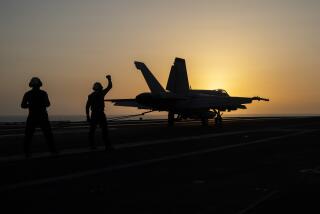Coalition Bombs Iraqi Hub in ‘No-Fly’ Zone
WASHINGTON — U.S. and British warplanes bombed an Iraqi air defense operations center Thursday after President Saddam Hussein’s troops fired on allied aircraft dropping leaflets warning his military not to target jets patrolling two “no-fly” zones.
The bombing of the command center near Tallil, about 160 miles southeast of Baghdad, was the latest in an aggressive series of airstrikes against Iraqi air defenses launched by the U.S. and Britain as they step up the tempo of patrols and bombing missions.
It was the third time in eight days that coalition warplanes have launched strikes in the area, aimed at destroying communications equipment, control radar and a surface-to-air missile launcher.
The no-fly zones, which Baghdad does not recognize, were imposed by the U.S. and Britain following the 1991 Persian Gulf War to protect a ethnic Kurdish enclave in northern Iraq and Shiite Muslim areas in the south.
Defense Secretary Donald H. Rumsfeld recently announced that U.S. and British warplanes patrolling the no-fly zones had shifted tactics from bombing small batteries of antiaircraft missiles to targeting major Iraqi air defense sites.
He said he had ordered the change within the last six months because he was tired of having U.S. planes fired upon with “impunity,” but military officials acknowledged that the move could help clear air corridors for an allied attack.
Since then, Iraq has fired on coalition aircraft 68 times, including 15 times in the last week, military officials said.
The U.S. and Britain have retaliated, bringing to 46 the number of “strike days” reported this year by the Pentagon. On some days, more than one area or site is bombed. Repeat missions have become common. On Tuesday, coalition aircraft struck for the sixth time in a month near Al Kut, about 100 miles southeast of Baghdad, because Iraqis keep moving mobile radar equipment to the area, Pentagon officials said.
Thursday’s strike targeted an Iraqi command post in the south. The Pentagon said the site was a communications hub for radar surveillance and antiaircraft missile sites in the southern no-fly zone.
The Pentagon said the Iraqi strike intended to down one of dozens of U.S. planes dropping thousands of leaflets over southern Iraq.
The leaflets depict a warplane bombing a missile launcher and a radar site with the message in Arabic: “Iraqi ADA [air defense artillery] Beware! Don’t track or fire on coalition aircraft!”
“The destruction experienced by your colleagues in other air defense locations is a response to your continuing aggression toward planes of the coalition forces,” the leaflets say, according to an English translation provided by defense officials. “No tracking or firing on these aircraft will be tolerated. You could be next.”
More to Read
Sign up for Essential California
The most important California stories and recommendations in your inbox every morning.
You may occasionally receive promotional content from the Los Angeles Times.










